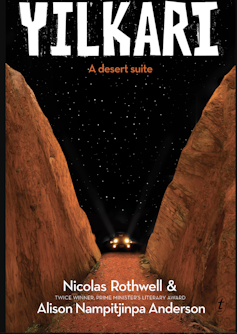‘A country to be heard and danced’: journeying into Australia’s menacing interior spaces
- Written by Tim Rowse, Emeritus Professor, Institute for Culture and Society, Western Sydney University

In the four parts that make up Yilkari – “Valentin”, “Dylan”, “Captain” and “Master” – men spend a lot of time engaging in venturesome outback driving and superbly eloquent talking.
Review: Yilkari: a desert suite – Nicolas Rothwell and Alison Nampitjinpa Anderson (Text Publishing)
In three of the four stories (each centred on the character whose name it bears), their journeys are along roads first carved into the dirt of the homelands of western desert Aboriginal people in the 1950s, when Commonwealth surveyor Len Beadell sought to make the region more serviceable as a Cold War weapons-testing range.
Yilkari honours Beadell while questioning our colonising expectation of mastering Australia’s vast dry interior. Not only distance emerges as a formidable tyrant. Yilkari’s central idea is that Australia’s interior spaces are – spiritually – both impenetrable and menacing.
While civilisation’s insecure purchase on Australia’s deserts enables “freedom” to the “drifter” – two important words in this book – these sparsely populated spaces embody the ineffable, powerful and unforgiving spirits of all who have dwelt there over thousands of years.
To experience their presence, Yilkari’s characters find, is to receive intimations of one’s own death. To know and accept the desert’s grim majesty is the basis of a cosmology that, in these four tales, belongs only to Aboriginal people and to misfits who have cleaved to them.
Yikari begins with a note to readers explaining it was written in tandem “by people who had become each other’s authors”: writer Nicolas Rothwell and his wife, artist Alison Nampitjinpa Anderson, a Luritja-Pintupi woman.
This book will divide readers. To enjoy it, I had to suspend my belief that humans do not converse with the philosophical ease, wit and dialogical generosity of the narrator and his companions.
As an historian of Central Australia’s colonisation and some time investigator of some of its human problems, I was aware of myself conceding to the authors their preoccupation with questions more transcendental. Is one human life little or big? Meaningfully structured or random? Is truth a place?
These are not my questions, but they may be some readers’. The narrator’s inexhaustibly eloquent negative capability may exert, for such readers, the anti-heroic appeal of the Romantic poets.
Hearing through the silence
Each story is narrated by an “I”, and the narrator’s interlocutors do not address him by name. That the narrator is, in all four stories, the same person is confirmed in the book’s final pages when – for only the second time – a woman speaks.
This time it’s an Aboriginal woman – Narulya, the narrator’s partner. Their conversation – planning a long drive through the western desert – refers to his friendships and travels that have comprised the four stories in Yilkari.
She observes that his stories are “always from somewhere else”, and he agrees, adding “they’re much too true to life, they can’t catch the mind or touch the heart”, unlike the stories she knows and that he cannot know. She consoles him.
But if you listen, out in the desert, I mean really listen, listen hard, sometimes you can almost hear the country singing them. Hear through the silence. And we might hear that music, where we’re going, where the old desert travellers were, those nomads.
Hearing is the most important action performed by Yilkari’s characters. As linguists Nick Evans and David Wilkins pointed out in their 2000 paper In the Mind’s Ear, when Aboriginal languages use a sensory metaphor to refer to our capacity for understanding, they mostly use verbs referring to listening and hearing, not – as in English – verbs referring to “seeing”. (“I see what you mean”.)
Lake Disappointment’s map coordinates are those given by Lovecraft (22 degrees 3’ 14" South Latitude, 125 degrees 0’ 39" East Longitude) for the stronghold of that novel’s “alien race who switch bodies with their human victims and travel back and forth.”
Arriving at Kumpupintil, the narrator and Johnson join camp with three veterans of World War II who explain their twofold goal: to honour Len Beadell by using his roads and to get to Corunna Downs Airfield, the secret base of bombing raids on the Dutch East Indies by B24 bombers. (It is now a ruin, and Johnson had once photographed it.)
Flying back from a mission, the veterans recall, the crew had seen mysterious shapes and patterns in the sky and, mindful of “the flames of Surabaya” (the result of their bombing raid), they had longed for their own destruction, to “be freed from what we knew, be washed clean and pure.” Now, nearing the end of their lives, visiting the remains of Corunna Downs would “draw out the great circle of our lives. Complete the arc.”
Yilkari has the feeling of an end-of-life reflection. In its closing pages, the narrator is with Narulya at a desert place where singing can be faintly heard, though the singers cannot be seen. Narulya warns him to be quiet and not approach the voices. This is the narrator’s epiphany.
In empty desert, far from everything you know, in darkness, in boundlessness – it comes. And a conviction formed in me, though my mind immediately rejected it, yet it lingered: the notion that there is a structure to our time on Earth, a trajectory, and beyond the horizon of our being all one day will be shown.
As Narulya explains, when they are safely distant, what he has just heard are “the songs and ceremonies that last forever – the sweet pure voices of the dead”.
Authors: Tim Rowse, Emeritus Professor, Institute for Culture and Society, Western Sydney University



